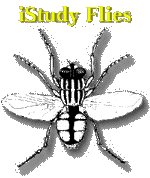|
iStudy Flies - Flies: The Life History of the Fly
Flies: The Life History of the Fly
In the study of insects (entomology), flies (plural; fly singular)
are any two-winged insect of the order Diptera (Di - two, and ptera
- wings) [DIP-ter-a], while most other insects have two sets of wings. Various flies
can be described as common in their frequency (the housefly, Musca domestica),
painful in their bite (the horse fly, Family Tabanidae), and sometimes medically
useful in their application (the blowfly maggot, in the debridement or removal of
dead flesh). In a hypothetical calculation, a pair of flies -- where a fly would
take up 1/8 cubic inch (2.05 cc) -- that began to breed in April, if all were to
live, would produce 191 quintillion 10 quadrillion (191,010,000,000,000,000,000)
flies by August, which would cover a sphere the size of our planet earth 47 feet
deep (14.3 m). Thankfully, this will never happen, because predators, parasites,
and other factors prevent this from occurring! [1]
Beneficial, useful, or even necessary are probably not the words that come to your
mind, when you think of flies. For instance, the mosquito, which is a type of
true fly, is eaten by bats; and, a colony of bats in Texas consumes 500,000 pounds
(226,796 kg) of mosquitoes every night. [2] Besides the mosquitoes feeding the bats, a fly fisherman could tell you
that the mosquito feeds the juvenile tarpon as their primary food source -- and the
trout love them, too; but, mosquitoes also keep human and animal populations down,
when they spread disease, i.e., survival of the fittest. [3] Dr. Elizabeth Willott, an entomologist
from the University of Arizona, Tucson, discussed in a June 2004 article "Restoring
nature, without the mosquitoes?" in Restoration Ecology (Volume 12, Issue
2, pp. 147-153), the ecological reality that the restoration of wetlands brings alive
the habitat of mosquitoes and mosquito-vectored diseases, such as the West Nile virus.
She pointed out that more discussion should take place about the risks of wetlands,
as well as discussing the management of those risks, e.g., the possible introduction
of endangered native species of fish, such as the Gila topminnow or desert pupfish,
which feed upon and control wetlands mosquitoes. [4]
When considering the role of the fly, probably the most common word that we find
to describe them would understandably be "pest" -- and possibly, "pestilence"
-- but, the fly maggot is especially essential to break down and redistribute organic
matter. The waste products of maggots provide nutrients for molds, fungi, and plants.
The true significance or importance of flies, for that reason, lies beyond the negative
impact of the Medfly, housefly, or mosquito, but "rather in the large numbers
of unfamiliar species that are an essential element in the food chains upon which
all life depends," as noted by entomologist, Harold Oldroyd. [5] Flies should be considered part of
a much greater web or food chain, that supports life far beyond their pestilent existence.
In any ecosystem, as intricate as its food web is, it appears that "everything
is connected to everything else." [6] Think of flies as forming links in a food chain, which can be seen in the
following children's rhyme.
Links In A Food Chain
Author Unknown
There once was a flower that grew on the plain.
Where the sun helped it grow, and so did the rain--
Links in a food chain.
There once was a bug who nibbled on flowers,
Nibbled on flowers for hours and hours!
The bug ate the flower that grew on the plain,
Where the sun helped it grow, and so did the rain--
Links in a food chain.
There once was a bird who gobbled up bugs,
And creepies and crawlies, and slimies and slugs.
The bird ate the bug, who nibbled on flowers,
Nibbled on flowers for hours and hours!
The bug ate the flower that grew on the plain,
Where the sun helped it grow, and so did the rain--
Links in a food chain.
There once was a snake who often grabbed birds,
And swallowed them whole, or so I have heard.
The snake ate the bird, who gobbled up bugs,
And creepies and crawlies, and slimies and slugs.
The bird ate the bug, who nibbled on flowers,
Nibbled on flowers for hours and hours!
The bug ate the flower that grew on the plain,
Where the sun helped it grow, and so did the rain--
Links in a food chain.
There once was a fox, and I'll make a bet:
He'd eat anything he could possibly get.
The fox ate the snake, who often grabbed birds,
And swallowed them whole, or so I have heard.
The snake ate the bird, who gobbled up bugs,
And creepies and crawlies, and slimies and slugs.
The bird ate the bug, who nibbled on flowers,
Nibbled on flowers for hours and hours!
The bug ate the flower that grew on the plain,
Where the sun helped it grow, and so did the rain--
Links in a food chain.
The fox, he grew older and died one spring day,
But he made the soil rich, when he rotted away.
A new flower grew where he died on the plain.
And the sun helped it grow, and so did the rain--
LINKS IN A FOOD CHAIN. [7]
|

